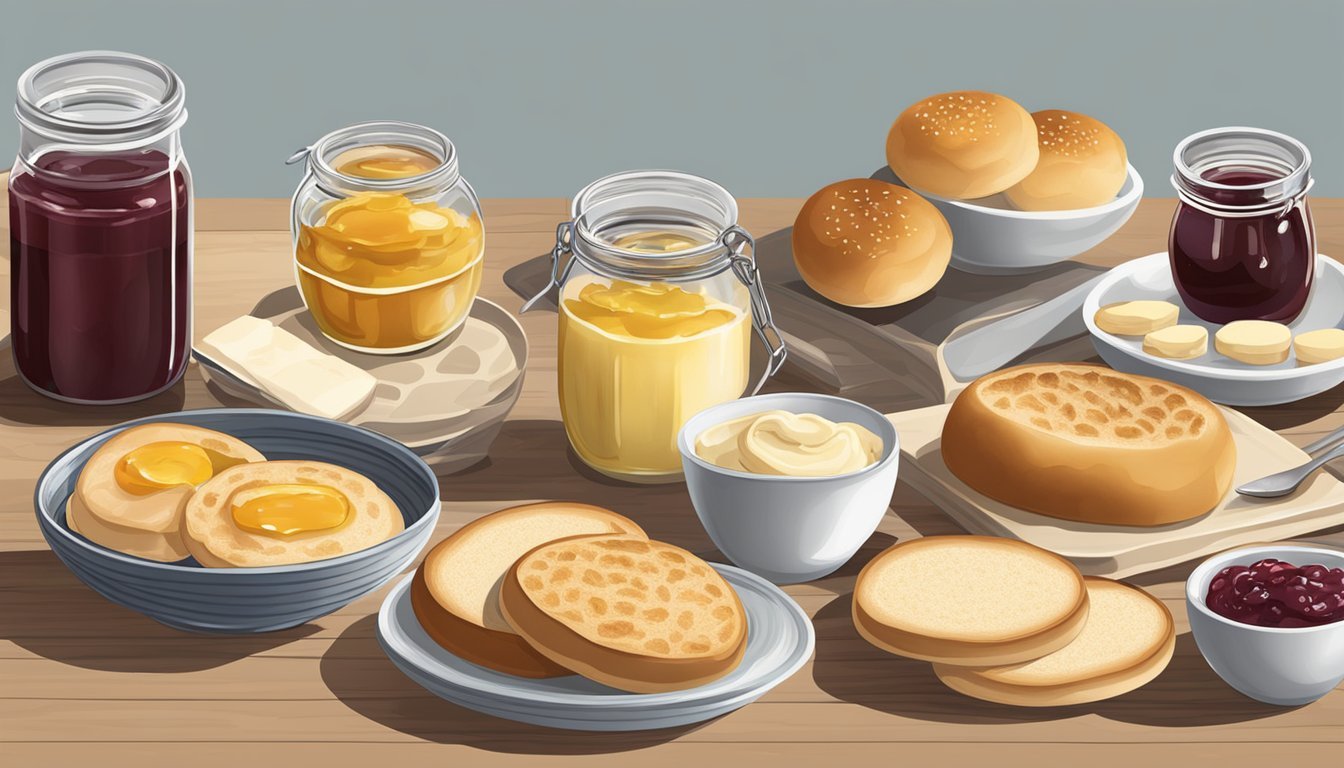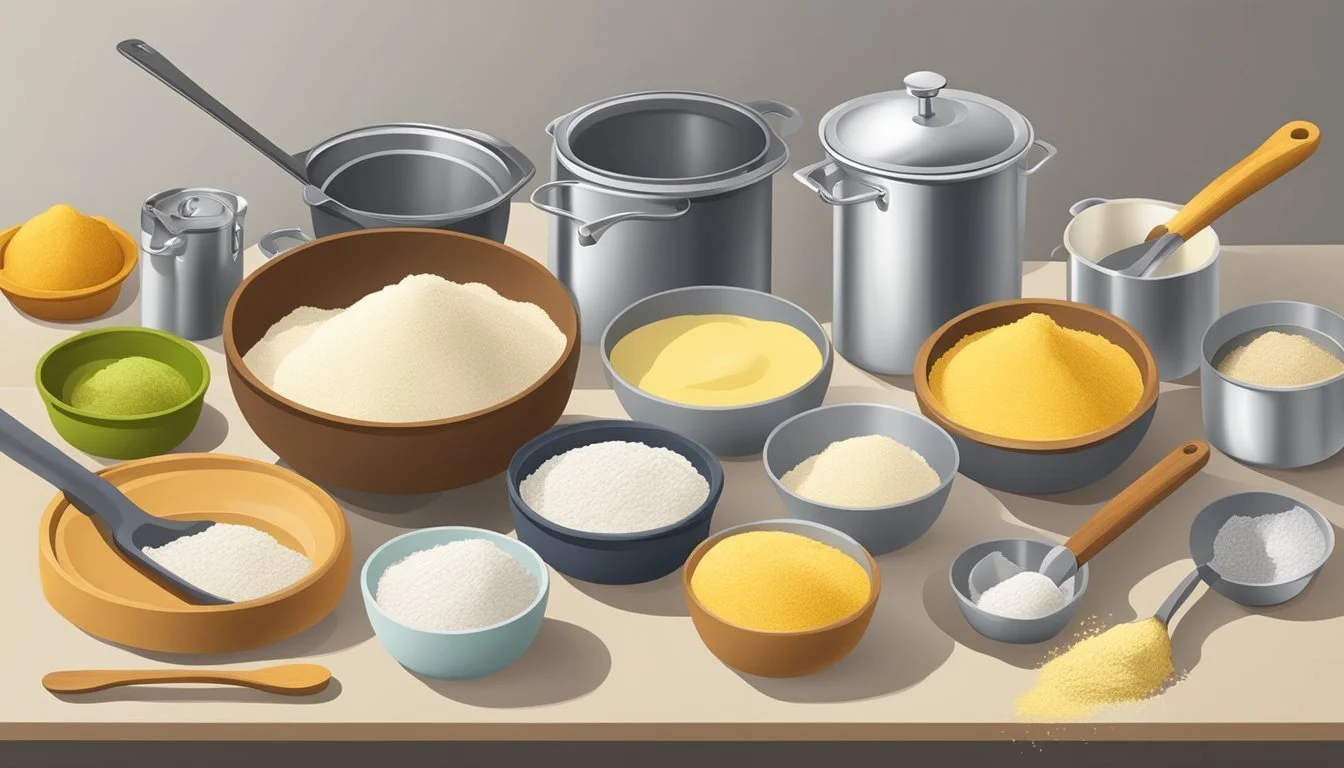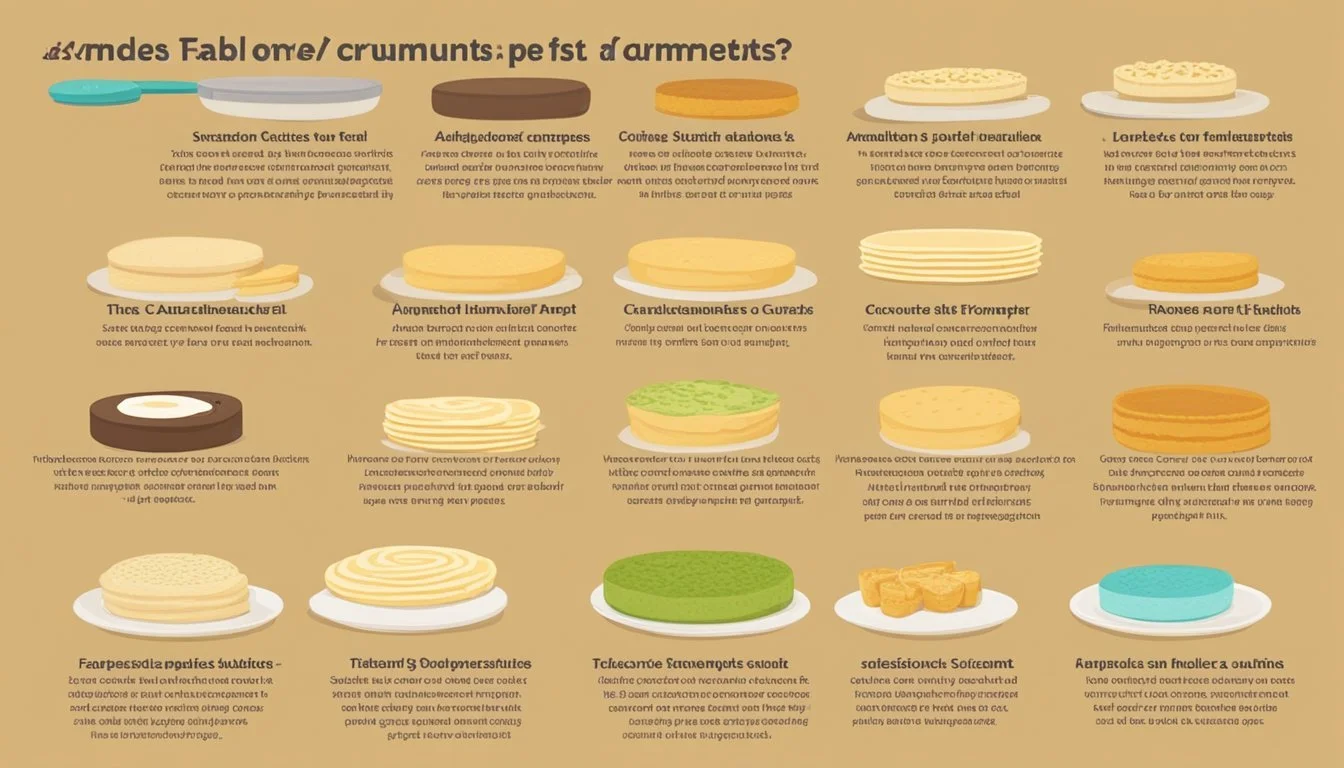Crumpet Substitutes
Top Alternatives for Your Tea-Time Treats
Crumpets, a quintessential British comfort food known for their distinctive texture and flavor, are a breakfast and teatime staple. They are traditionally made with a yeast batter, which includes flour and water, and sometimes milk, resulting in a deliciously chewy treat replete with characteristic holes that are perfect for absorbing butter, jams, or honey. Crumpets are typically cooked in crumpet rings, which are metal or silicone guides that help to keep the batter in a uniform shape as it cooks, contributing to their classic structure.
However, not everyone has access to crumpet rings, and in such cases, kitchen improvisation becomes necessary. Resourceful cooks have found that various substitutes can work as alternatives to crumpet rings to retain the general size and form of crumpets. The use of aluminum rings or clean, empty food cans with both ends removed are two simple yet effective solutions. These makeshift forms aid in creating the crumpet's famed shape and depth without having to purchase specialized equipment.
Thus, whether one chooses to use a traditional crumpet ring or an alternative method, the key to achieving the perfect crumpet lies in the batter's consistency and the cooking process. Ensuring the batter is not overly thick and allowing it to rise properly with the help of yeast results in the soft, porous texture crumpets are celebrated for. Despite the tools at hand, baking enthusiasts can enjoy making and indulging in this beloved treat, experimenting with different tools to perfect their own homemade versions.
Understanding Crumpets
In exploring the world of crumpets, one discovers a rich history, distinctive ingredients, and a unique set of characteristics that have firmly positioned this bread as a staple in UK homes, particularly for breakfast and afternoon tea.
History and Origin
Crumpets trace back to the UK where they have long been a fixture of breakfast and afternoon tea. Originally made with just flour and water, over time ingredients like milk, sugar, and yeast bolstered their culinary profile.
Key Ingredients
Crumpets comprise flour, baking powder or baking soda for leavening, salt, and water or milk. Sugar is often added for a subtle sweetness, and active dry yeast or instant yeast is used to create the batter's signature holes with its bubbly texture.
Crumpet Characteristics
Crumpets are known for their golden color and soft texture, featuring nooks and crannies perfect for holding delicious toppings like butter, jam, or honey. Their texture is spongier than that of an English muffin, with more moisture and larger, more defined holes.
Nutritional Profile
In terms of nutrition, crumpets contain calories predominantly from carbohydrates. Each crumpet's nutrition can vary based on the ingredients used but is generally a source of energy with minimal fat content.
Culinary Uses
Crumpets serve as a versatile breakfast bread. They are commonly enjoyed with sweet toppings such as jam, butter, honey, or lemon curd, and savory options like bacon, avocado, cheese, peanut butter, or Vegemite.
Storage and Shelf Life
To keep crumpets fresh, store them in an airtight container in the fridge where they can last several days, or freeze to extend their shelf life. When properly stored in the freezer, crumpets can last for up to one month.
Making Crumpets at Home
Making crumpets at home is a straightforward process involving a yeasted batter that requires proper mixing and resting time. By understanding the basics and a few key techniques, one can easily prepare crumpets from scratch, adapt the recipe for personal preferences, and troubleshoot common baking issues.
Basic Crumpet Recipe
A simple crumpet recipe begins with warming milk to activate yeast, often with a touch of sugar to hasten the process. Ingredients typically include:
Flour: To form the base of the batter.
Yeast: For leavening, creating fluffiness as it causes the batter to rise.
Salt: To enhance flavor.
Instructions:
Activate Yeast: Dissolve yeast in warm milk with sugar and wait until frothy.
Mix Dry Ingredients: Whisk together flour and salt in a separate bowl.
Combine and Rest: Add yeast mixture to flour, beat until smooth, and allow the batter to rest, enabling the yeast to proof and the batter to rise.
Techniques for Perfect Crumpets
Temperature Control: The pan should be preheated to a medium-high temperature to ensure that crumpets cook evenly without burning.
Ring Molds: Utilizing crumpet rings, often aluminum for non-stick properties, keeps the batter confined to form the traditional shape and capture the characteristic holes on the top surface.
Cooking Time: Typically, the first side of a crumpet cooks for a few minutes until bubbles form and burst, after which it is flipped to cook briefly on the other side.
Substitutions and Variations
For those with dietary preferences or restrictions:
Vegan: Replace milk with plant-based alternatives and eliminate any butter. Gluten-Free: Opt for gluten-free flour while ensuring that the texture remains suitable for crumpet making.
Sweet or Savory: Sweeten the batter with honey or create a savory version by adding herbs.
Troubleshooting Common Issues
If crumpets don't rise, check the yeast's activity or ensure the batter is not overmixed which can deflate the batter.
Sticky crumpets might indicate a too-wet batter; add a little more flour to achieve the right consistency.
Poor hole formation may result from an improper resting time or cooking temperature. Adjust and ensure the batter has sufficient time to proof.
Alternative Tools for Crumpet Making
When making crumpets, the right tools can enhance the cooking process. Specific alternatives to traditional crumpet rings can provide similar results, and knowing how to best use your pan and utensils ensures successful crumpet flipping and removal.
Substitutes for Crumpet Rings
Traditional crumpet rings might not always be available. In such cases, one can opt for aluminum rings, as they are a widely accessible and affordable option. For those seeking a non-metal alternative, silicone rings serve as a suitable choice due to their non-stick qualities and flexibility. Everyday kitchen items such as mason jar lids or cut-open cans with both ends removed also make effective makeshift crumpet molds. Additionally, egg rings or muffin rings made from stainless steel can be utilized, ensuring the batter is confined to the desired shape.
Preparing Your Pan
The use of a non-stick pan is important to prevent crumpets from sticking and tearing during cooking. A frying pan or griddle, properly heated, ensures even cooking. It is advisable to lightly grease the selected substitute ring and the surface of the pan with non-stick spray or a small amount of oil. This helps in easy release and uniform browning of the crumpets.
Flipping and Removal
Once the crumpets start to take shape, flipping becomes necessary to cook them evenly on both sides. They should be flipped carefully using a spatula or tongs. After cooking, removal from the rings should be done gently to keep their shape intact. If the batter sticks, gently rolling it into balls can help separate it from the ring. In cases where homemade tools like aluminum foil are used, care should be taken to peel away the foil without damaging the crumpets.
Crumpet Alternatives and Varieties
Discovering alternatives to crumpets offers a world of bread-like options, ranging from local variations to global influences, ensuring that dietary preferences like vegan or gluten-free are catered to with satisfying substitutes.
Close Relatives of Crumpets
English Muffins: They are a popular alternative to crumpets, offering a similar texture and taste. While crumpets are known for their spongy interior riddled with holes, English muffins are denser and split into halves before toasting.
Pikelets: Often considered a crumpet's thinner cousin, pikelets are a lighter option that do not require rings for cooking, making them a more accessible choice for those without specialized kitchenware.
International Variants
Blinis: Originating from Russia, blinis are traditionally made from buckwheat flour, offering a savory option that pairs well with a variety of toppings, from smoked salmon to creme fraiche.
Dorayaki: These sweet Japanese pancakes sandwich a variety of fillings, often sweet red bean paste, providing an international twist to the crumpet that is both different in taste and presentation.
Diet-Specific Alternatives
Vegan Crumpets: Vegan crumpets substitute dairy ingredients with plant-based alternatives such as soy or almond milk, as well as vegan butter, ensuring that those following a vegan diet can still enjoy a similar experience.
Gluten-Free Options: Gluten-free alternatives often utilize a blend of rice, potato, tapioca, and maize flours to mimic the traditional texture of crumpets, making this beloved British delicacy accessible to those with gluten intolerance.
By exploring these crumpet alternatives and varieties, individuals can enjoy a diverse range of bread-like treats that accommodate different cultural tastes and dietary needs.
Serving and Toppings
When considering substitutes for crumpets, serving them warm with a variety of toppings can enhance their appeal and taste. The right toppings can transform these substitutes into delightful snacks or breakfast items, complementing their texture and flavor profiles.
Traditional Toppings
Butter: A classic choice, it melds into the warm, porous surface, creating a rich and creamy layer of flavor.
Cheese: Melted cheese offers a savory note, with options ranging from sharp cheddar to smooth cream cheese.
Bacon: For a hearty addition, crispy bacon provides a satisfying crunch and smoky taste.
Avocado: Slices or mashed avocado deliver a creamy texture and a subtle, buttery taste, often paired with a sprinkle of salt or a dash of lemon.
Lemon: A zest of lemon juice adds a bright, tangy accent, especially when combined with a light spread of butter or honey.
Honey & Jam: Sweet spreads like honey or jam offer a contrasting flavor that complements the base's savory nature.
Peanut Butter: Offers a creamy or crunchy option with a nutty taste, often enjoyed with a drizzle of honey.
Vegemite: An acquired taste, Vegemite imparts a robust, salty and umami-rich dimension, typically favored thinly spread.
Incorporating these toppings on crumpet substitutes allows for a range of flavors from earthy and umami to sweet and zesty, ensuring there's a combination to suit every palate.
Conclusion
When seeking alternatives for crumpet rings, one has several practical options to consider. Aluminum rings stand out as a popular choice, being both easily obtainable and conducive to consistent baking results. Their durability and ease of maintenance further solidify their position as a worthwhile substitute.
For those who prefer the satisfaction of creating homemade crumpets, the journey of preparing batter from scratch is both simple and rewarding. One can achieve a desirable texture and flavor, reflective of the time-honored tradition of crumpet making.
Substitute Options:
Aluminum Rings: Affordable and dishwasher safe
Mason Jar Lids: Available and handy
Cookie Cutters: Diverse shapes and sizes
DIY Alternatives: Customizable and inventive
Homemade Crumpets:
Ingredients: Accessible and versatile
Process: Straightforward with gratifying results
Outcome: Enjoyment of fluffy, warm crumpets
A crumpet, be it part of a classic British breakfast or a base for a savory sandwich, is a culinary delight that invites creativity. Whether purchased from a store or conjured up in one’s own kitchen, the crumpet experience can be both simple and satisfying, as one indulges in its characteristic chew and pore-rich texture.
FAQs and Tips
This section offers a spectrum of quick answers, helpful hints, and creative twists, complemented with expert advice for those embarking on the journey of making crumpets without traditional rings.
Unexpected Questions
Can I make crumpets without rings? Yes, alternative tools such as well-greased mason jar lids, egg rings, or cookie cutters can shape crumpets effectively.
How can I prevent batter from sticking? Greasing substitutes with oil or non-stick spray before pouring in the batter ensures a smooth release after cooking.
Expert Tips
Heat Control: Achieving the perfect crumpet involves cooking on medium-low heat to ensure thorough cooking without burning the outsides.
Batter Consistency: For well-formed crumpets, maintain a batter that's thick yet pourable, similar to a pancake batter.
Recipe Variations
Gluten-Free: Replace traditional flour with gluten-free alternatives and allow the batter to rest, ensuring the flour fully absorbs the liquid.
Vegan Options: Utilize plant-based milk and egg substitutes to cater to vegan dietary requirements, without compromising on the texture and taste.








